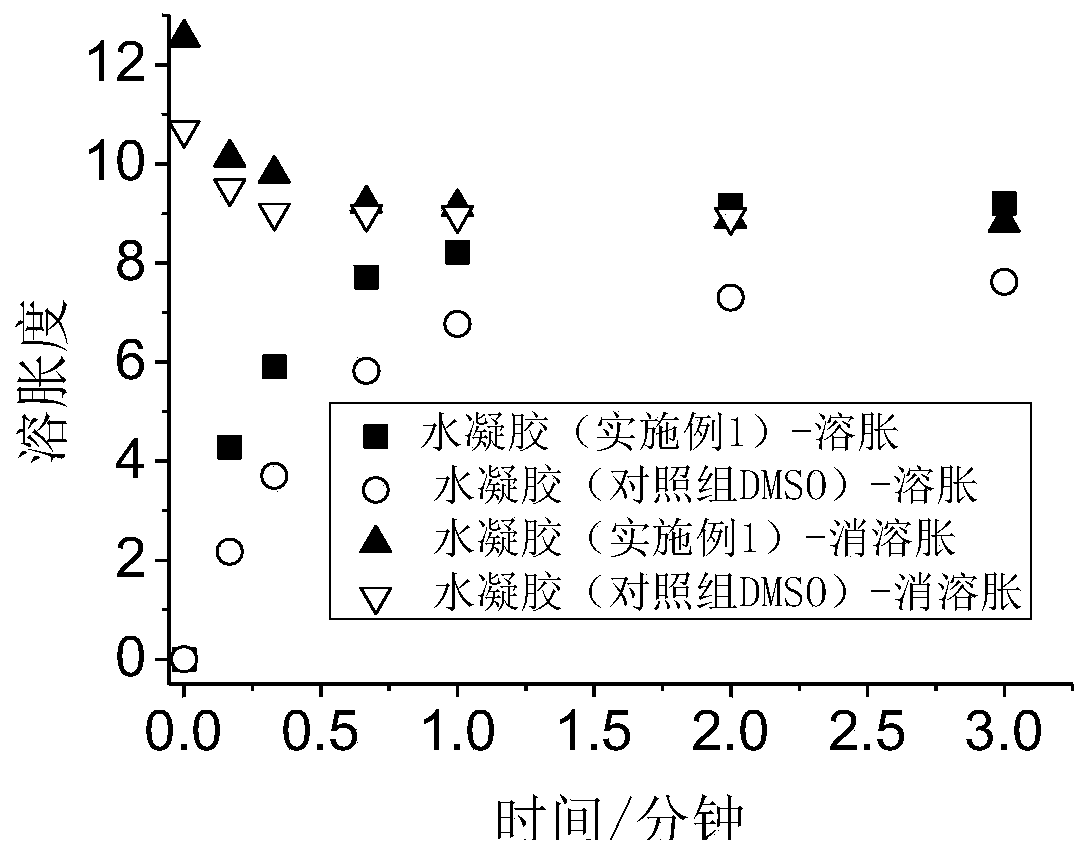Method for preparing quick-response temperature-sensitive hydrogel by adopting room-temperature eutectic solvent liquid frontal polymerization
A deep eutectic solvent and fast-response technology, applied in the field of functional polymer material preparation, can solve the problems of reducing production energy consumption, large pollution, and easy residue, etc., and achieve the goal of reducing production energy consumption, reducing production costs, and shortening reaction time Effect
- Summary
- Abstract
- Description
- Claims
- Application Information
AI Technical Summary
Problems solved by technology
Method used
Image
Examples
Embodiment 1
[0028] (1) Mix 1.13g of N-isopropylacrylamide, 6g of urea, and 13.8g of triethylamine hydrochloride and stir at 100°C until a transparent and clear liquid is formed, then cool to room temperature to obtain a room temperature deep eutectic solvent liquid;
[0029] (2) Add 0.21g N,N'-methylenebisacrylamide and 0.42g potassium persulfate to the room temperature deep eutectic solvent liquid obtained in step (1) to form a mixture solution, and then transfer the formed mixture solution to Into the reactor test tube, use an electric soldering iron to heat the upper end of the reactor, so that the initiator is heated and decomposed to initiate the reaction. After the thermal initiation reaction starts, the heat source is removed until the raw materials in the entire reactor are completely converted into polymer gels;
[0030] (3) Soak and wash the polymer gel obtained in step (2) with distilled water to remove triethylamine hydrochloride, and freeze-dry the polymer gel after soaking an...
Embodiment 2
[0033] (1) Mix 2.26g of N-isopropylacrylamide, 12g of urea, and 13.8g of triethylamine hydrochloride and stir at 100°C until a transparent and clear liquid is formed, then cool to room temperature to obtain a room temperature deep eutectic solvent liquid;
[0034](2) Add 0.42g N,N'-methylene bisacrylamide and 0.88g ammonium persulfate to the room temperature deep eutectic solvent liquid obtained in step (1) to form a mixture solution, and then transfer the formed mixture solution to Into the reactor test tube, use ultraviolet light to irradiate the upper end of the reactor to initiate the reaction. After the initiation reaction begins, evacuate the ultraviolet light source until the raw materials in the entire reactor are completely converted into polymer gels;
[0035] (3) Soak and wash the polymer gel obtained in step (2) with distilled water to remove triethylamine hydrochloride, and freeze-dry the polymer gel after soaking and washing to obtain the target rapid response tem...
Embodiment 3
[0038] (1) Mix 2.26g of N-isopropylacrylamide, 6g of urea, and 29.5g of tetrabutylphosphonium chloride and stir at 100°C until a transparent and clear liquid is formed, then cool to room temperature to obtain a room temperature deep eutectic solvent liquid;
[0039] (2) Add 0.38g N,N'-methylenebisacrylamide and 0.78g potassium persulfate to the room temperature deep eutectic solvent liquid obtained in step (1) to form a mixture solution, and then transfer the formed mixture solution to Into the reactor test tube, use an electric soldering iron to heat the upper end of the reactor, so that the initiator is heated and decomposed to initiate the reaction. After the thermal initiation reaction starts, the heat source is removed until the raw materials in the entire reactor are completely converted into polymer gels;
[0040] (3) The polymer gel obtained in step (2) is soaked and washed with distilled water to remove tetrabutylphosphonium chloride, and the polymer gel after soaking ...
PUM
 Login to View More
Login to View More Abstract
Description
Claims
Application Information
 Login to View More
Login to View More - R&D Engineer
- R&D Manager
- IP Professional
- Industry Leading Data Capabilities
- Powerful AI technology
- Patent DNA Extraction
Browse by: Latest US Patents, China's latest patents, Technical Efficacy Thesaurus, Application Domain, Technology Topic, Popular Technical Reports.
© 2024 PatSnap. All rights reserved.Legal|Privacy policy|Modern Slavery Act Transparency Statement|Sitemap|About US| Contact US: help@patsnap.com










